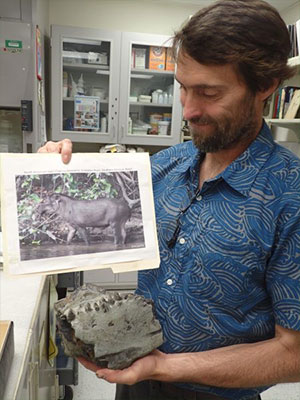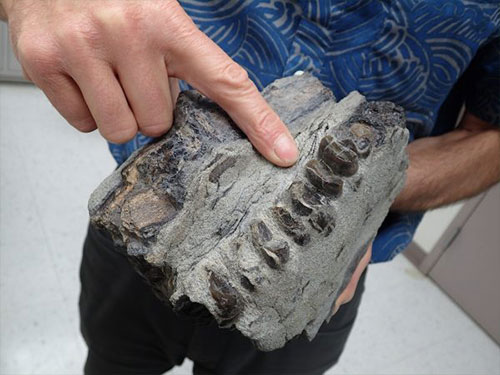
Tapir’s jaw an ‘incredibly rare’ findBy NED ROZELL
August 18, 2018
Five experts on ancient creatures slept in Klein’s Homer house last month as they searched local cliffs for another chunk of a mammal that lived in Alaska millions of years ago. Her guests were Patrick Druckenmiller of the UA Museum of the North, Grant Zazula and Susan Hewitson of the Yukon government, paleontologist Analia Forasiepi of Argentina, and Ross MacPhee, curator of mammology at the American Museum of Natural History in New York.
Along with Klein, a Homer resident and naturalist, the scientists were looking for a rock that might fit into the petrified jawbone of a tapir that Klein’s grandson Kai found about a year ago on a beach near Homer. Kai Reising, then 5, was beachcombing in July 2017 with his grandmother; his mother, Deborah Klein; his father George Reising; and his younger brother Silas. In an area where the family had found cool things on other outings, Kai picked up a rock with both hands. “Kai went over thinking it was a big piece of fossilized wood,” Klein said. “When he turned it over, his mom said, ‘It has teeth!’ “The minute we saw the teeth, we knew a scientist had to look at it.” Klein has a trained eye for unusual rocks; years ago, she found fragments of a mammoth tusk and ankle bone on the Kenai Peninsula. She didn’t know what the tapir was, but she knew it wasn’t a contemporary of the mammoth, which survived until perhaps 10,000 years ago. “I knew it had nothing to do with a Pleistocene animal,” she said. The family carried the rock from the beach. Soon after, Janet Klein visited Druckenmiller and UAF paleontologist Kevin May in Sutton, where they were doing work. They were jazzed at the pearl-green teeth protruding from the rock. “Those are just super diagnostic,” Druckenmiller said. “They suggested it was rhino-like,” Klein said. “By the time he got back up (to Fairbanks), Patrick was pretty sure it was a tapir.” Druckenmiller thinks this Alaska tapir was alive about 10 million years ago. Related to rhinos, horses and zebras, tapirs live today in Central and South America, as well as the swamps of Malaysia and Sumatra. They are the size of a state fair hog and look like pigs with trunks. Their noses and upper lips extend to allow tapirs to grip vegetation. Their design has endured. “The tapir has not changed a lot,” Druckenmiller said. “Its teeth have been the same for 50 million years. They’ve figured it out and have stuck to it.”
Alaskans have many times seen the imprint of tropical leaves in rocks and sequoia stumps that suggest rich prehistoric ecosystems existed here. Until now, no one had found fossilized remains of the mammals that roamed those warm forests millions of years ago. “It’s an incredibly rare find — at least we think it is,” said Druckenmiller, who enjoys when major discoveries come walking through the door or land in his email inbox. “Any day can be Christmas: You just never know — no, it’s a little rarer than Christmas.” He will soon wrap the jaw up and place it in an Action Packer. He will carry it through security at Fairbanks International Airport and tote it to New York City. There, at the American Museum of Natural History, he will hand the jaw over to specialists who will clean the specimen and expose more of the tapir’s features. “It could be a new species,” Druckenmiller said. “But we’ll let (Ross MacPhee, of the American Museum of Natural History) tell that story. As for the recent search of the tapir beach with the other experts, Druckenmiller and his colleagues did not find any more parts. But Janet Klein vows to search that stretch of coast at least every six weeks. “Maybe someday we’ll get lucky and find some more of it,” Druckenmiller said. “A lot of the major finds in paleontology are not made by paleontologists.”
Representations of fact and opinions in comments posted are solely those of the individual posters and do not represent the opinions of Sitnews.
|
|||||

